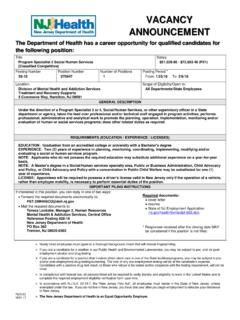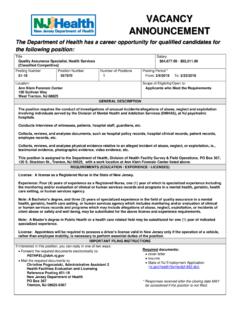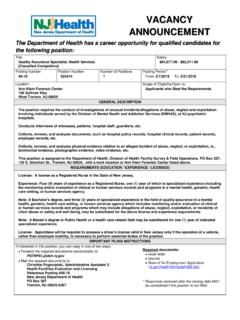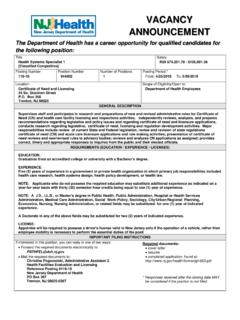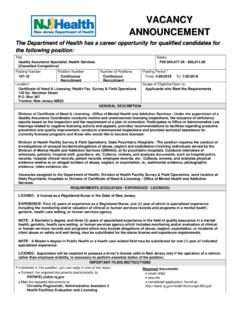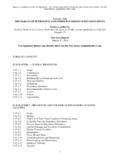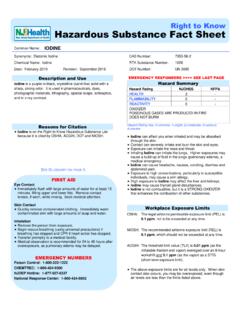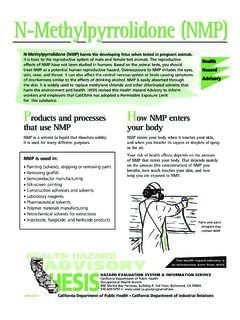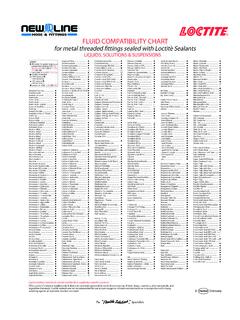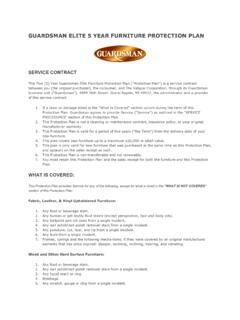Transcription of Right to Know Hazardous Substance Fact Sheet
1 Right to Know Hazardous Substance Fact Sheet Common Name: cyclohexane Synonyms: Benzene Hexahydride; Hexahydrobenzene; Hexamethylene Chemical Name: cyclohexane Date: June 2009 Revision: March 2016 CAS Number: 110-82-7 RTK Substance Number: 0565 DOT Number: UN 1145 Description and Use cyclohexane is a colorless liquid with a sweet, pungent odor. It is used as a solvent and paint remover , in analytical chemistry, and in making adhesives and perfumes. ODOR THRESHOLD = 25 ppm Odor thresholds vary greatly. Do not rely on odor alone to determine potentially Hazardous exposures. Reasons for Citation cyclohexane is on the Right to Know Hazardous Substance List because it is cited by OSHA, ACGIH, DOT, NIOSH, DEP, NFPA and EPA.
2 This chemical is on the Special Health Hazard Substance List. SEE GLOSSARY ON PAGE 5. FIRST AID Eye Contact Immediately flush with large amounts of water for at least 15 minutes, lifting upper and lower lids. Remove contact lenses, if worn, while flushing. Seek medical attention. Skin Contact Quickly remove contaminated clothing. Immediately wash contaminated skin with large amounts of soap and water. Inhalation Remove the person from exposure. Begin rescue breathing (using universal precautions) if breathing has stopped and CPR if heart action has stopped. Transfer promptly to a medical facility. EMERGENCY NUMBERS Poison Control: 1-800-222-1222 CHEMTREC: 1-800-424-9300 NJDEP Hotline: 1-877-927-6337 National Response Center: 1-800-424-8802 EMERGENCY RESPONDERS >>>> SEE LAST PAGE Hazard Summary Hazard Rating NJDHSS NFPA HEALTH - 1 FLAMMABILITY - 3 REACTIVITY - 0 FLAMMABLE POISONOUS GASES ARE PRODUCED IN FIRE CONTAINERS MAY EXPLODE IN FIRE Hazard Rating Key: 0=minimal; 1=slight; 2=moderate; 3=serious; 4=severe cyclohexane can affect you when inhaled.
3 Contact can irritate and burn the skin and eyes. Inhaling cyclohexane can irritate the nose and throat. Prolonged or repeated contact can cause a skin rash, dryness, itching and redness. Exposure can cause headache, dizziness, lightheadedness, and passing out. cyclohexane may damage the liver and kidneys. cyclohexane is a FLAMMABLE LIQUID and a DANGEROUS FIRE HAZARD. Workplace Exposure Limits OSHA: The legal airborne permissible exposure limit (PEL) is 300 ppm averaged over an 8-hour workshift. NIOSH: The recommended airborne exposure limit (REL) is 300 ppm averaged over a 10-hour workshift. ACGIH: The threshold limit value (TLV) is 100 ppm averaged over an 8-hour workshift.
4 cyclohexane Page 2 of 6 Determining Your Exposure Read the product manufacturer s Material Safety Data Sheet (MSDS) and the label to determine product ingredients and important safety and health information about the product mixture. For each individual Hazardous ingredient, read the New Jersey Department of Health Hazardous Substance Fact Sheet , available on the RTK website ( ) or in your facility s RTK Central File or Hazard Communication Standard file. You have a Right to this information under the New Jersey Worker and Community Right to Know Act, the Public Employees Occupational Safety and Health (PEOSH) Act if you are a public worker in New Jersey, and under the federal Occupational Safety and Health Act (OSHA) if you are a private worker.
5 The New Jersey Right to Know Act requires most employers to label chemicals in the workplace and requires public employers to provide their employees with information concerning chemical hazards and controls. The federal OSHA Hazard Communication Standard (29 CFR ) and the PEOSH Hazard Communication Standard ( 12:100-7) require employers to provide similar information and training to their employees. This Fact Sheet is a summary of available information regarding the health hazards that may result from exposure. Duration of exposure, concentration of the Substance and other factors will affect your susceptibility to any of the potential effects described below. Health Hazard Information Acute Health Effects The following acute (short-term) health effects may occur immediately or shortly after exposure to cyclohexane : Contact can irritate and burn the skin and eyes.
6 Inhaling cyclohexane can irritate the nose and throat causing coughing and wheezing. Exposure can cause headache, dizziness, nausea and vomiting, lightheadedness, drowsiness, and passing out. Chronic Health Effects The following chronic (long-term) health effects can occur at some time after exposure to cyclohexane and can last for months or years: Cancer Hazard According to the information presently available to the New Jersey Department of Health, cyclohexane has not been tested for its ability to cause cancer in animals. Reproductive Hazard There is no evidence that cyclohexane affects reproduction. This is based on test results presently available to the NJDHSS from published studies.
7 Other Effects Prolonged or repeated contact can cause a skin rash, dryness, itching and redness. cyclohexane may damage the liver and kidneys. Medical Medical Testing For frequent or potentially high exposure (half the TLV or greater), the following are recommended before beginning work and at regular times after that: Liver and kidney function tests Any evaluation should include a careful history of past and present symptoms with an exam. Medical tests that look for damage already done are not a substitute for controlling exposure. Request copies of your medical testing. You have a legal Right to this information under the OSHA Access to Employee Exposure and Medical Records Standard (29 CFR ).
8 Mixed Exposures More than light alcohol consumption can cause liver damage. Drinking alcohol can increase the liver damage caused by cyclohexane . cyclohexane Page 3 of 6 Workplace Controls and Practices Very toxic chemicals, or those that are reproductive hazards or sensitizers, require expert advice on control measures if a less toxic chemical cannot be substituted. Control measures include: (1) enclosing chemical processes for severely irritating and corrosive chemicals, (2) using local exhaust ventilation for chemicals that may be harmful with a single exposure, and (3) using general ventilation to control exposures to skin and eye irritants.
9 For further information on workplace controls, consult the NIOSH document on Control Banding at The following work practices are also recommended: Label process containers. Provide employees with hazard information and training. Monitor airborne chemical concentrations. Use engineering controls if concentrations exceed recommended exposure levels. Provide eye wash fountains and emergency showers. Wash or shower if skin comes in contact with a Hazardous material. Always wash at the end of the workshift. Change into clean clothing if clothing becomes contaminated. Do not take contaminated clothing home. Get special training to wash contaminated clothing. Do not eat, smoke, or drink in areas where chemicals are being handled, processed or stored.
10 Wash hands carefully before eating, smoking, drinking, applying cosmetics or using the toilet. In addition, the following may be useful or required: Before entering a confined space where cyclohexane may be present, check to make sure that an explosive concentration does not exist. Where possible, transfer cyclohexane from drums or other containers to process containers in an enclosed system. Personal Protective Equipment The OSHA Personal Protective Equipment Standard (29 CFR ) requires employers to determine the appropriate personal protective equipment for each hazard and to train employees on how and when to use protective equipment. The following recommendations are only guidelines and may not apply to every situation.
